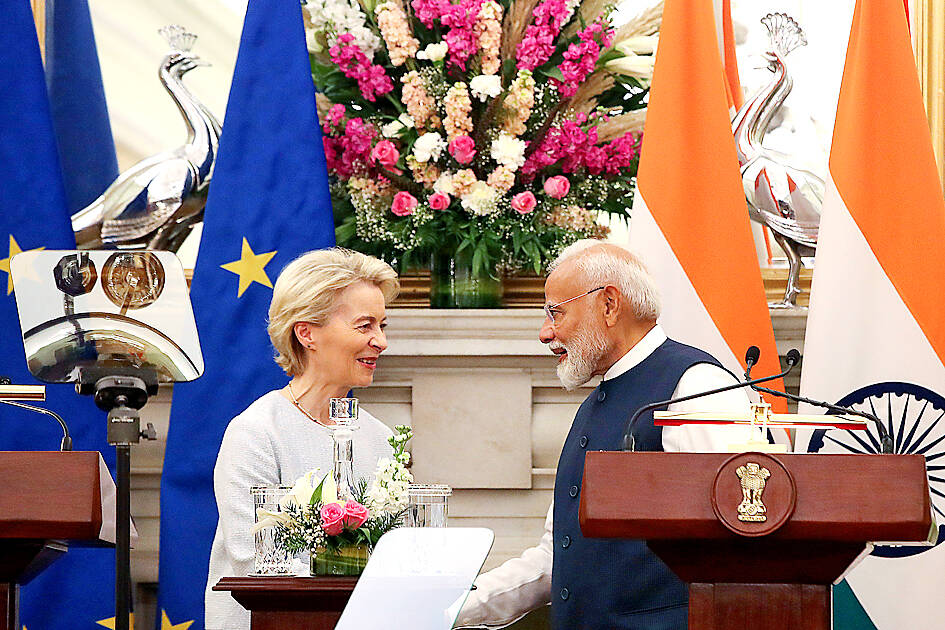India’s economy grew by 6.2 percent in the October-to-December period, marginally below expectations, but faster than in the previous quarter, on the back of increased government and consumer spending, data released yesterday showed.
The growth in GDP was slightly lower than the 6.3 percent expansion projected by analysts in a Reuters poll, and the central bank’s estimate of 6.8 percent. The world’s fifth-biggest economy grew 5.6 percent in the previous quarter.
The third-quarter GDP growth is marginally better than expectations, IDFC First Bank India economist Gaura Sengupta said.

Photo: EPA-EFE
The pickup in growth momentum reflects some improvement in listed companies’ profit growth with moderation in input cost, she added.
Agriculture growth also showed a strong pickup, led by robust Kharif crop output. Meanwhile, on the demand side, private consumption growth picked up reflecting revival in rural demand.
“After incorporating Q3 FY25 GDP, we still see FY25 full-year GDP at 6.2 percent to 6.3 percent. We continue to expect a shallow rate-cut cycle from the [Reserve Bank of India] RBI with another 25bps to 50bps cut in 2025. Depreciation pressure on INR [rupee] will keep the rate-cut cycle shallow in our view,” she said.
Stepping back, the big picture is that the economy is still fairly soft by India’s recent standards.
Capital Economics assistant economist Harry Chambers said that with the RBI shifting its priorities from controlling inflation to supporting growth, economic activity should begin to pick up further.
This week’s reversal of the tighter bank lending restrictions introduced in late 2023, as well as the further monetary policy loosening expected from the central bank, would boost household consumption and investment, he said.
Emkay Global Financial Services chief economist Madhavi Arora said: “Massive upward revisions to past years and quarters have made the GDP forecast exercise extremely dynamic. However, backed by the current quarterly estimates by [National Statistical Office] NSO for FY25TD, the implied 4QFY25 GDP estimate appears to be a high 7.7 percent, a tall ask given the current macro dynamics.”
Another economist, Jahnavi Prabhakar from the Bank of Baroda said: “[Gross value added] GVA growth for Q3 came in line with our expectations and GDP growth surprised positively.”
However, a strong 6.5 percent growth for this year turns out to be much higher than the RBI estimation is a strong positive, she said.
A further revival is expected in the fourth quarter, supported by consumption spending and a rebound in investment cycle, Prabhakar said, adding that rate cut expectations also bodes well for the growth outlook.
Kotak Mahindra Bank chief economist Upasna Bhardwaj said that despite the sharp upward revisions to the last two years’ GDP figures, this year’s figures appear to have remained resilient, although led largely by the upward revisions to the second-quarter figures.
“We expect the FY25 GDP figure to be lower than the central statistics office’s estimate by around 20-30 basis points,” she said. “We expect FY26 growth of around 6.4 percent, but the outlook remains heavily clouded with downside risks amid global trade uncertainties.”

Taiwanese suppliers to Taiwan Semiconductor Manufacturing Co. (TSMC, 台積電) are expected to follow the contract chipmaker’s step to invest in the US, but their relocation may be seven to eight years away, Minister of Economic Affairs J.W. Kuo (郭智輝) said yesterday. When asked by opposition Chinese Nationalist Party (KMT) Legislator Niu Hsu-ting (牛煦庭) in the legislature about growing concerns that TSMC’s huge investments in the US will prompt its suppliers to follow suit, Kuo said based on the chipmaker’s current limited production volume, it is unlikely to lead its supply chain to go there for now. “Unless TSMC completes its planned six

Intel Corp has named Tasha Chuang (莊蓓瑜) to lead Intel Taiwan in a bid to reinforce relations between the company and its Taiwanese partners. The appointment of Chuang as general manager for Intel Taiwan takes effect on Thursday, the firm said in a statement yesterday. Chuang is to lead her team in Taiwan to pursue product development and sales growth in an effort to reinforce the company’s ties with its partners and clients, Intel said. Chuang was previously in charge of managing Intel’s ties with leading Taiwanese PC brand Asustek Computer Inc (華碩), which included helping Asustek strengthen its global businesses, the company

Power supply and electronic components maker Delta Electronics Inc (台達電) yesterday said second-quarter revenue is expected to surpass the first quarter, which rose 30 percent year-on-year to NT$118.92 billion (US$3.71 billion). Revenue this quarter is likely to grow, as US clients have front-loaded orders ahead of US President Donald Trump’s planned tariffs on Taiwanese goods, Delta chairman Ping Cheng (鄭平) said at an earnings conference in Taipei, referring to the 90-day pause in tariff implementation Trump announced on April 9. While situations in the third and fourth quarters remain unclear, “We will not halt our long-term deployments and do not plan to

TikTok abounds with viral videos accusing prestigious brands of secretly manufacturing luxury goods in China so they can be sold at cut prices. However, while these “revelations” are spurious, behind them lurks a well-oiled machine for selling counterfeit goods that is making the most of the confusion surrounding trade tariffs. Chinese content creators who portray themselves as workers or subcontractors in the luxury goods business claim that Beijing has lifted confidentiality clauses on local subcontractors as a way to respond to the huge hike in customs duties imposed on China by US President Donald Trump. They say this Chinese decision, of which Agence